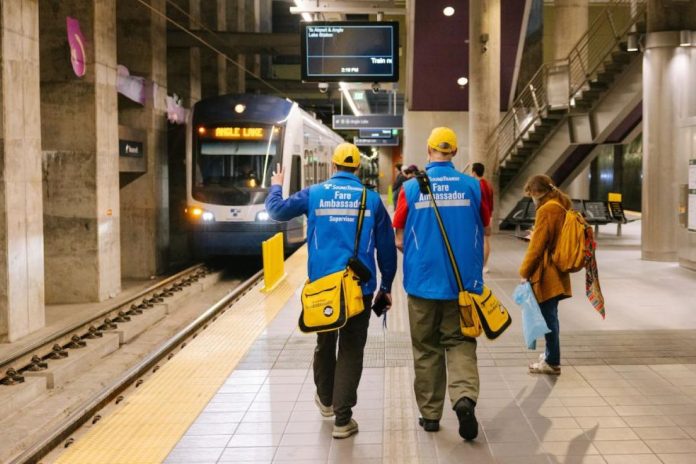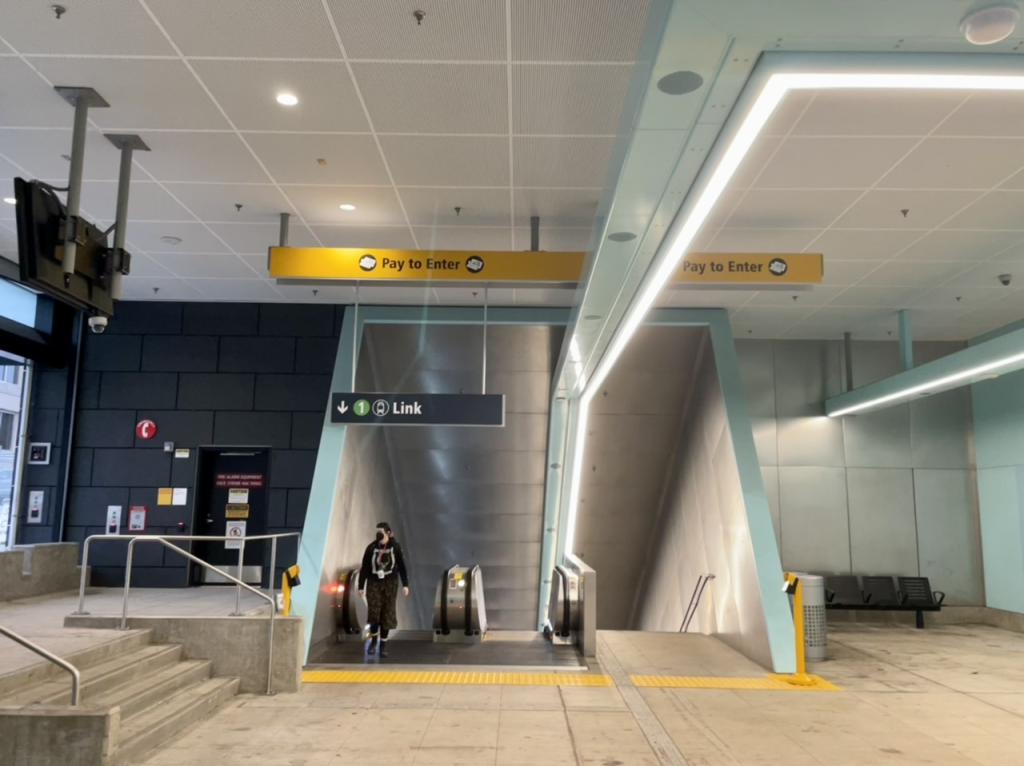
Sound Transit is rolling out another iteration of its fare compliance protocols. Fare ambassadors will implement a new system of fare inspections on and around platforms at some Link light rail stations starting on Monday, June 3. This follows the reintroduction of tighter fare compliance protocols launched last fall, as the agency has been staffing up the fare ambassador team.
The new system will be phased in across the Link system, but initially only stations on the 1 Line with a marked “fare paid zone” will be affected by the changes. Fare paid zones are clearly delineated with yellow floor markings and signage, and are lined with ORCA readers at the zone entrances.
Newer stations in the Link system already contain fare paid zones, but Sound Transit rolled out a project in 2022 to expand them to more stations, initially with a focus on Downtown Seattle. Establishing fare paid zones entails installing new markings and signage at mezzanine and street-level entrances, relocating ORCA readers, and installing ticket vending machines near zone entrances.

In the first phase, fare ambassadors will implement the new inspection protocol at stations in Downtown Seattle, and progressively expand it to additional stations following the opening of the Lynnwood Link Extension later this summer. In tandem with the new inspection protocol, fare ambassadors will continue to conduct fare inspections onboard trains.
Starting June 3, riders can expect inspections to take place within fare paid zones. When fare ambassadors conduct inspections on platforms, they will methodically inspect all riders on the platform, only temporarily pausing inspections when announcements of “train now arriving” are made. Fare ambassadors split into two teams, start inspections from the far end of platforms, and work their way toward the middle.
Sound Transit believes this strategy will allow for more efficient fare inspection, particularly at peak hours, which are expected to see heavier traffic once the Lynnwood Link Extension opens. Fare ambassadors will also help riders navigate stations and direct them toward payment kiosks.
Riders found to be out of compliance with fare policies will be recorded into the agency database and issued a violation by fare ambassadors. Under agency policies, fare ambassadors use a rolling 12 month look-back period to determine fare violation consequences.
During the look-back period, the first two interactions will result in warnings, and third and fourth interactions result in violations that must be resolved through non-monetary options (such as loading the fine amount on an ORCA card or participating in a fare violation resolution class) or paying a fine ($50 fine for the third interaction and $75 fine for the fourth interaction). A fifth or beyond interaction will result in a $124 civil infraction and could be referred to the court system.
Youth aged 18 and younger are eligible to participate in the Free Youth Fare program. Youth are encouraged to register, obtain, and use a Free Youth Transit Pass, but fare ambassadors will accept verbal age confirmation to determine if a fare-free ride is acceptable.
The new fare enforcement protocol has been long in the works. When the Sound Transit board authorized changes to the fare compliance program in 2022, the policy scope called for fare enforcement not just on vehicles but also in fare paid zones. Some boardmembers have also pushed for installing fare gates at stations, although that proposal appears to have been shelved and was only brought to light by a public records request by The Urbanist.
As part of the new inspection protocol, Sound Transit will be evaluating and refining how it works. That will include engagement with riders through an online survey to collect feedback.
Stephen is a professional urban planner in Puget Sound with a passion for sustainable, livable, and diverse cities. He is especially interested in how policies, regulations, and programs can promote positive outcomes for communities. With stints in great cities like Bellingham and Cork, Stephen currently lives in Seattle. He primarily covers land use and transportation issues and has been with The Urbanist since 2014.


